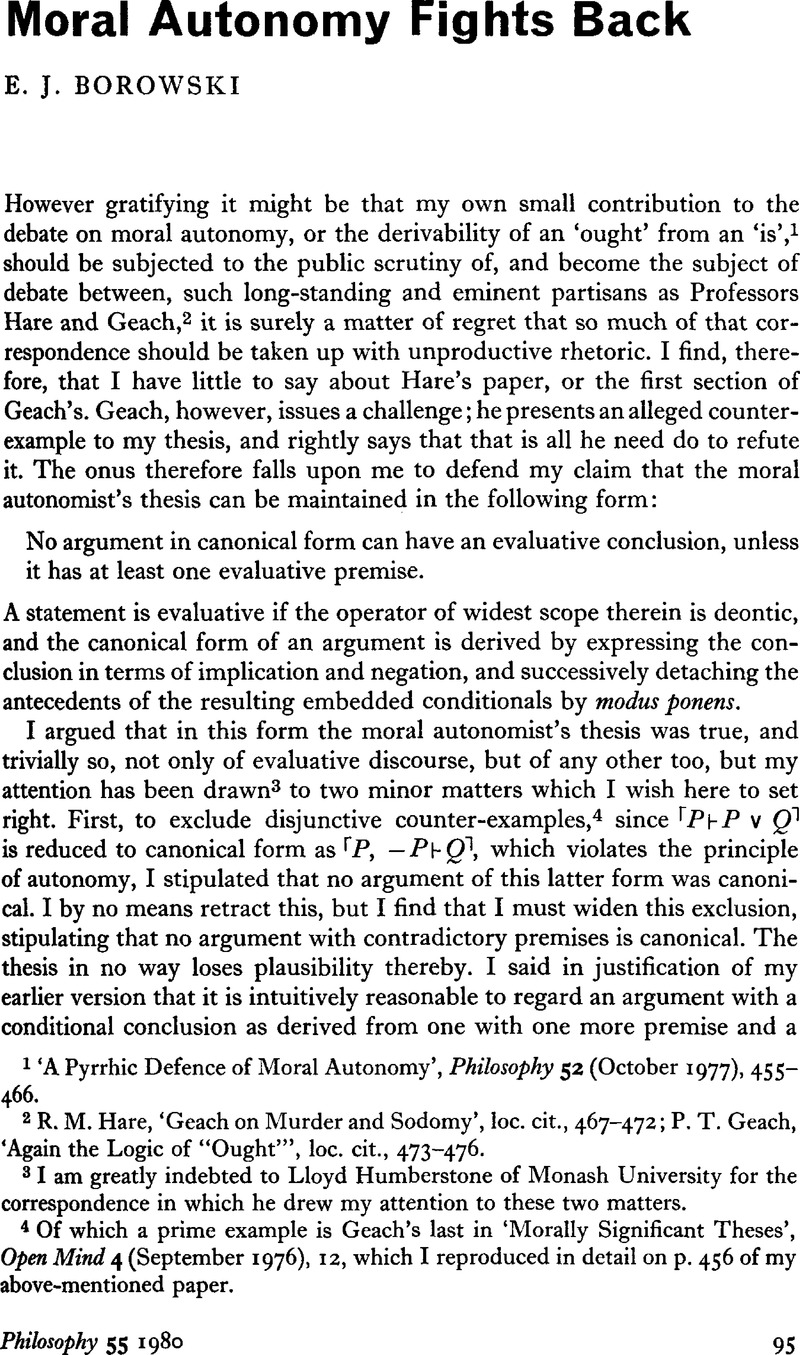Published online by Cambridge University Press: 30 January 2009

1 ‘A Pyrrhic Defence of Moral Autonomy’, Philosophy 52 (10 1977), 455–466.Google Scholar
2 Hare, R. M., ‘Geach on Murder and Sodomy’, loc. cit., 467–472Google Scholar; Geach, P. T., ‘Again the Logic of “Ought”’, loc. cit., 473–476.Google Scholar
3 I am greatly indebted to Lloyd Humberstone of Monash University for the correspondence in which he drew my attention to these two matters.
4 Of which a prime example is Geach's last in ‘Morally Significant Theses’, Open Mind 4 (09 1976), 12Google Scholar, which I reproduced in detail on p. 456 of my above-mentioned paper.
5 Hare, R. M., The Language of Morals (Oxford: Clarendon Press, 1952), 1.Google Scholar
6 The terminology is that of Hare, R. M., ‘Meaning and Speech Acts’, Philosophical Review 79 (1970)CrossRefGoogle Scholar; see also pp. 460–462 of my earlier paper.
7 ‘Morally Significant Theses’ (see note 4 above) and ‘Murder and Sodomy’, Philosophy 51 (07 1976).Google Scholar
8 Cf. Searle, John, ‘How to Derive “Ought” from “Is”’, Philosophical Review 73 (1964), 43–58CrossRefGoogle Scholar, and Chapters 3.1 (‘How to Promise: a Complicated Way’) and 8 (‘Deriving “Ought” from “Is”’) of Speech Acts (Cambridge: Cambridge University Press, 1969).Google Scholar Many of the points I would make against Searle are set out in detail in Hare, R. M., ‘The Promising Game’. Revue Internationale de Philosophie 70 (1964), 398–412.Google Scholar Both Searle's and Hare's papers are reprinted in Foot (ed.), Theories of Ethics (Oxford University Press, 1967)Google Scholar and Hudson, W. D. (ed.), The Is/Ought Question (Macmillan, 1969).CrossRefGoogle Scholar
9 Cf. Warnock, G. J., The Object of Morality (Methuen, 1971), 130ff.Google Scholar; Contemporary Moral Philosophy (Macmillan, 1967), 35.Google Scholar
10 ‘Geach on Murder and Sodomy’, loc. cit., 468.Google Scholar
11 Some other examples (in English) are cited in Broadie, Alexander, ‘Imperatives’, Mind 81 (04 1972), 180Google Scholar, in support of the view that ‘imperative’ is not a species of the genus ‘sentence’ distinguishable purely syntactically.
12 Geach, P. T., Logic Matters (Blackwell, 1972), 32ff.Google Scholar; Hare, , op. cit., 467Google Scholar; Geach, , ‘Again the Logic of “Ought”’, 473ff.Google Scholar